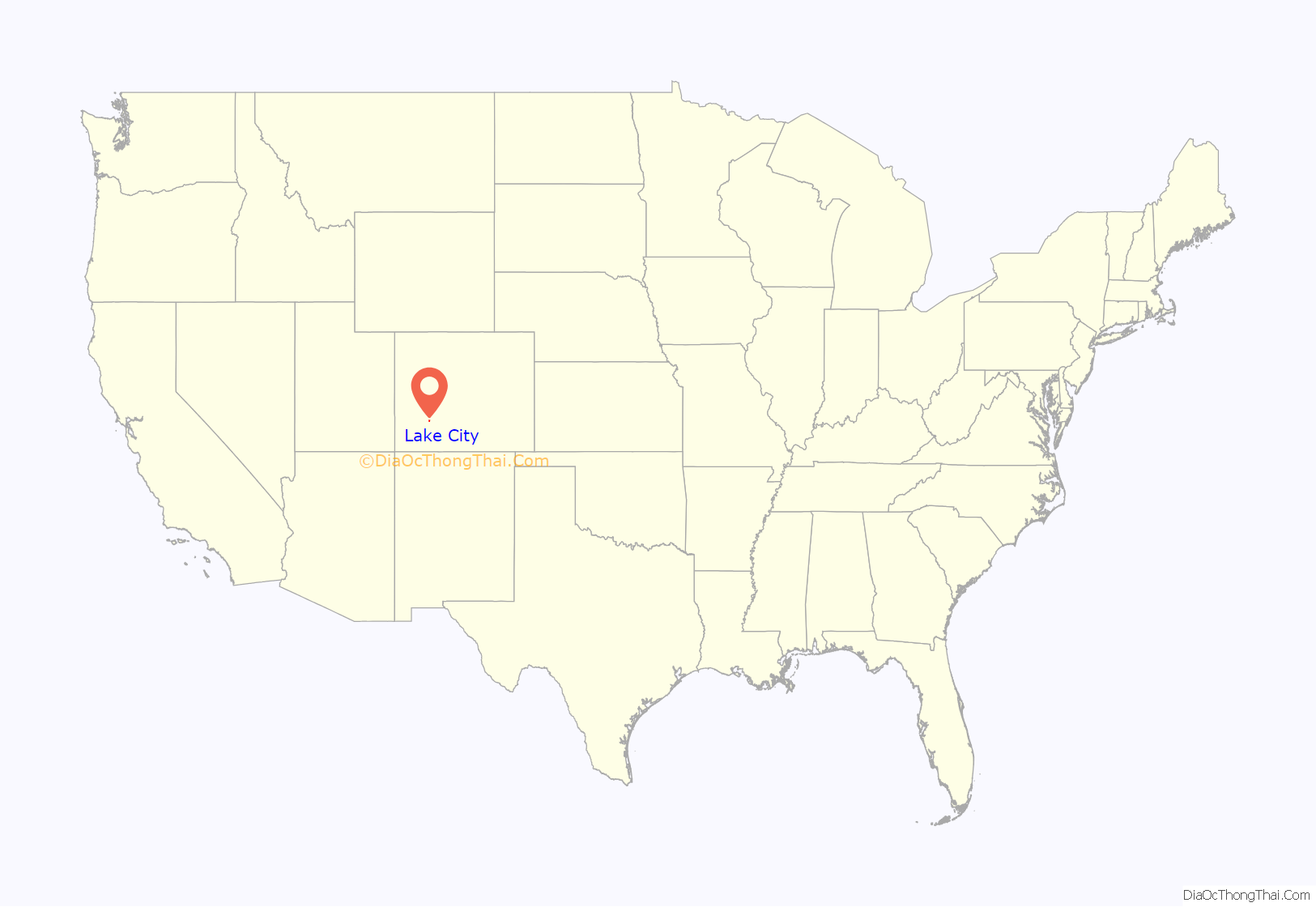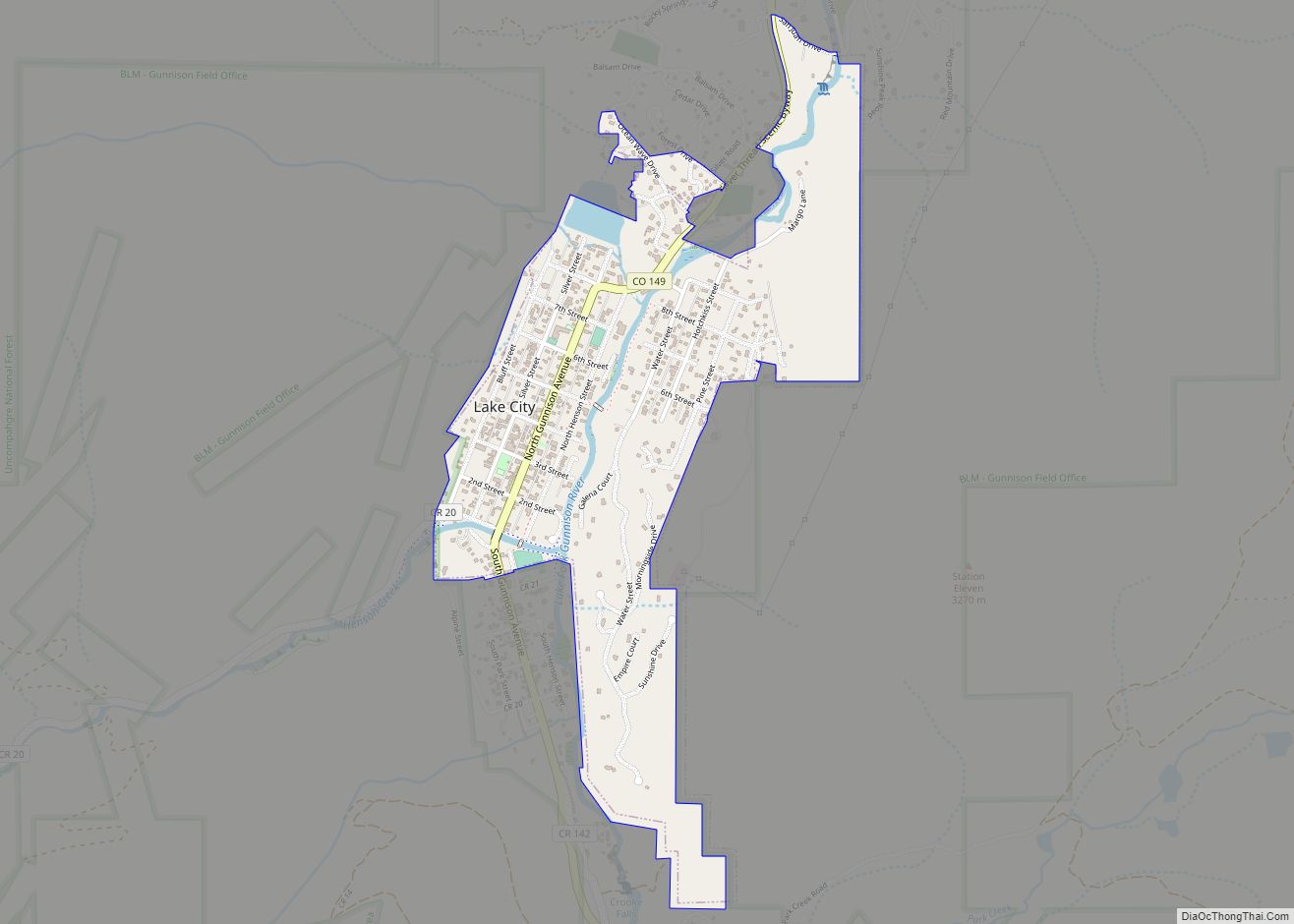Lake City is a statutory town that is the county seat, the most populous community, and the only incorporated municipality in Hinsdale County, Colorado, United States. The population was 432 at the 2020 census. It is located in the San Juan Mountains in a valley formed by the convergence of Henson Creek and the headwaters of the Lake Fork of the Gunnison River about seven miles (11 km) east of Uncompahgre Peak, a Colorado fourteener. Lake City is named after nearby Lake San Cristobal. This area lies at the southern end of the Colorado Mineral Belt and when rich mineral deposits were discovered the native population was pushed from their tribal lands and the town of Lake City was incorporated in 1873.
With the completion of the first road into the mountains in this region, Lake City served as a supply center for the many miners and prospectors flooding into the area. As a supply center, the town boomed to as many as 3,000 to 5,000 settlers. But as the first-discovered deposits were found to be only moderately productive and no new extensive or rich deposits of minerals were found, by 1879 the boom had subsided. With the arrival of the Denver & Rio Grande Railroad in 1889, Lake City saw a second upturn in the economy that lasted into the 1890s. The railroad cut the cost of shipping gold and silver ores to smelters, reduced the cost of shipping supplies into Lake City, and provided shipment of cattle and sheep into the area for summer grazing in the high Alpine meadows.
By 1905, the mining era was over and Lake City entered a decades-long period of economic decline. Population figures hovered at 1,000 then dropped to 400 after 1910. Although mining continued throughout the twentieth century, it consisted primarily of exploration and speculation rather than productive operation. Beginning in 1915, visitors began coming to Lake City for the entire summer season and by the 1930s tourism had emerged as a viable industry.
The Hinsdale County Historical Society formed in 1973 and began accumulating documents and photographs recording the town’s history. In 1978, the Lake City Historic District was listed in the National Register of Historic Places. Residents have restored many of the boom town mining era buildings and currently promote tourism as an industry. Restoration has not only aided the local economy by making Lake City a desirable tourist destination, it has served economic development with preservation projects creating jobs for local carpenters, craftsmen, and contractors. Lake City’s educational needs are served by the Lake City Community School.
| Name: | Lake City town |
|---|---|
| LSAD Code: | 43 |
| LSAD Description: | town (suffix) |
| State: | Colorado |
| County: | Hinsdale County |
| Elevation: | 8,661 ft (2,640 m) |
| Total Area: | 0.84 sq mi (2.17 km²) |
| Land Area: | 0.83 sq mi (2.14 km²) |
| Water Area: | 0.01 sq mi (0.03 km²) |
| Total Population: | 432 |
| Population Density: | 510/sq mi (200/km²) |
| ZIP code: | 81235 |
| Area code: | 970 |
| FIPS code: | 0842330 |
| GNISfeature ID: | 0188715 |
| Website: | www.lakecity.com |
Online Interactive Map
Click on ![]() to view map in "full screen" mode.
to view map in "full screen" mode.
Lake City location map. Where is Lake City town?
Lake City Road Map
Lake City city Satellite Map
Geography
Lake City is located at 38°1′55″N 107°18′43″W / 38.03194°N 107.31194°W / 38.03194; -107.31194 (38.031946, −107.311940).
According to the United States Census Bureau, the town has a total area of 0.9 square miles (2.3 km), of which, 0.8 square miles (2.1 km) of it is land and 1.18% is water.
In recent years, Lake City has become a destination for many Texans who bring their ATVs to ride the many rugged 2WD and 4WD roads in the area. Lake City is also known to many Colorado fourteener “peakbaggers” as the jumping-off point for five of Colorado’s 53 ranked 14,000′ peaks – Sunshine, Redcloud, Handies, Wetterhorn, and Uncompahgre.
Lake City experiences a continental climate (Köppen climate classification Dfb) that only just escapes being classified as semi-arid due to its relatively wet early springs and late autumns. On average, the wettest month is August, and the driest is February. Very large daily temperature swings are a regular feature of Lake City’s climate, due to the elevation and aridity.
See also
Map of Colorado State and its subdivision:- Adams
- Alamosa
- Arapahoe
- Archuleta
- Baca
- Bent
- Boulder
- Broomfield
- Chaffee
- Cheyenne
- Clear Creek
- Conejos
- Costilla
- Crowley
- Custer
- Delta
- Denver
- Dolores
- Douglas
- Eagle
- El Paso
- Elbert
- Fremont
- Garfield
- Gilpin
- Grand
- Gunnison
- Hinsdale
- Huerfano
- Jackson
- Jefferson
- Kiowa
- Kit Carson
- La Plata
- Lake
- Larimer
- Las Animas
- Lincoln
- Logan
- Mesa
- Mineral
- Moffat
- Montezuma
- Montrose
- Morgan
- Otero
- Ouray
- Park
- Phillips
- Pitkin
- Prowers
- Pueblo
- Rio Blanco
- Rio Grande
- Routt
- Saguache
- San Juan
- San Miguel
- Sedgwick
- Summit
- Teller
- Washington
- Weld
- Yuma
- Alabama
- Alaska
- Arizona
- Arkansas
- California
- Colorado
- Connecticut
- Delaware
- District of Columbia
- Florida
- Georgia
- Hawaii
- Idaho
- Illinois
- Indiana
- Iowa
- Kansas
- Kentucky
- Louisiana
- Maine
- Maryland
- Massachusetts
- Michigan
- Minnesota
- Mississippi
- Missouri
- Montana
- Nebraska
- Nevada
- New Hampshire
- New Jersey
- New Mexico
- New York
- North Carolina
- North Dakota
- Ohio
- Oklahoma
- Oregon
- Pennsylvania
- Rhode Island
- South Carolina
- South Dakota
- Tennessee
- Texas
- Utah
- Vermont
- Virginia
- Washington
- West Virginia
- Wisconsin
- Wyoming







